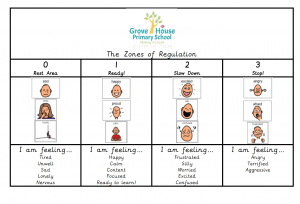Zones of Regulation
“WE ALL ENCOUNTER TRYING CIRCUMSTANCES THAT TEST OUR LIMITS FROM TIME TO TIME. IF WE ARE ABLE TO RECOGNISE WHEN WE ARE BECOMING LESS REGULATED, WE ARE ABLE TO DO SOMETHING ABOUT IT TO MANAGE OUR FEELINGS AND GET OURSELVES TO A HEALTHY PLACE. THIS IS THE GOAL OF THE ZONES OF REGULATION.”
– LEAH KUYPERS, CREATOR OF THE ZONES OF REGULATION

Why have we decided to use the Zones of Regulation?
- Lots of our pupils have poor emotional regulation.
- We need to prepare children for the next stage of their lives. Regulation as a life skill to help children to avoid unhealthy coping mechanisms in later life – addiction etc.
- It is highly regarded by Educational Psychologists, Bradford Behaviour Team and other SEMH professionals.
- It is part of the wider aim to continue to improve pupils’ behaviour, in turn impacting on pupil outcomes.
The Grove House approach to Zones of Regulation:
- Colours would not work at our school as it would have limited meaning to our visually impaired children.
- We feel everyone has different associations with colours – red does not always need to be angry!
- One the key drivers of everything we do is around expanding vocabulary – we do not want to limit children’s emotional vocabulary.
- We want to enhance our Reflection Areas and check-ins so all adults are modelling key vocabulary – this will eventually be internalised by the children.
What does the research say?
Evidence suggests early self-regulation development is an indicator for children’s later success. Early self regulation correlates with later outcomes (Mischel et al, 1970; Montroy et al, 2016).
Some of the adverse impacts of poverty are moderated by self-regulatory skills: Low-income children with better self-regulatory skills are more resilient to adverse psychological outcomes (Blair, 2010; Blair & Raver, 2012).
EEF: improves outcomes in EY by +5 months over the year. Teaching older primary pupils social and emotional skills can improve their development by +4 months over the year


